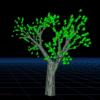I have a negascout function within an iterative deepening with aspiration windows framework. The negascout function uses move ordering, transposition tables, killer moves and history heuristics. The game is a nine men's morris (yes.. still working on it in my free time!!)
The problem is that over 70% of the time, the AI is not that aggressive, ie. when the AI has a chance to capture pieces, it doesn't.
This is the function:
private int negaScout(int curDepth, int maxDepth, int alpha, int beta)
{
if (curDepth >= maxDepth || board.getWon() != 0)
return board.getScore();
//Check if the move is in the TT
long key = board.getZobristKey();
TTEntry entry = tt.probe(key, curDepth);
if (entry != null)
{
switch (entry.boundType)
{
case TTEntry.BOUND_EXACT:
return entry.score;
case TTEntry.BOUND_ALPHA:
alpha = Math.max(alpha, entry.score);
break;
case TTEntry.BOUND_BETA:
beta = Math.min(beta, entry.score);
break;
}
if (alpha >= beta)
return entry.score;
}
int val = 0;
int bestScore = -INFINITY;
Move bestLocalMove = null;
boolean foundPV = false;
List<Move> moves = sortMoves(board, curDepth, false);
for (int i = 0, n = moves.size(); i < n; i++)
{
Move move = moves.get(i);
//PV has been found
if (alpha < bestScore)
{
alpha = bestScore;
foundPV = true;
}
board.make(move, true);
if (foundPV)
{
//Zero window
val = -negaScout(curDepth + 1, maxDepth, -alpha - 1, -alpha);
if (val > alpha && val < beta)
val = -negaScout(curDepth + 1, maxDepth, -beta, -alpha);
}
else
val = -negaScout(curDepth + 1, maxDepth, -beta, -alpha);
board.undo(move, true);
//Alpha has improved
if (val > bestScore)
{
bestScore = val;
bestLocalMove = move;
//Beta cut-off
if (bestScore >= beta)
break;
}
}
//We have the current best move so far at the root
if (curDepth == 0) bestMove = bestLocalMove;
//Set TT entry flag
byte flag = bestScore <= alpha ? TTEntry.BOUND_BETA :
bestScore >= beta ? TTEntry.BOUND_ALPHA : TTEntry.BOUND_EXACT;
//Store the move in the TT
tt.set(key, curDepth, bestScore, flag, bestLocalMove);
if (bestLocalMove != null)
{
//Add to killer moves
killers.add(bestLocalMove, curDepth);
//Update history heuristics for non-captures
if (bestLocalMove.cellRemove == -1)
history[bestLocalMove.player][bestLocalMove.cellFrom + 1][bestLocalMove.cellTo + 1] += 1<<(maxDepth-curDepth);
}
return bestScore;
}
This is the transpostion table:
public class TranspositionTable
{
private TTEntry[] tt;
public TranspositionTable(int size)
{
tt = new TTEntry[size];
}
public TTEntry probe(long key, int depth)
{
TTEntry entry = tt[(int)(key % tt.length)];
if (entry != null && entry.depth <= depth)
return entry;
return null;
}
public void set(long key, int depth, int val, byte boundType, Move move)
{
int pos = (int)(key % tt.length);
tt[pos] = new TTEntry(key, depth, val, boundType, move);
}
}
As you can see in the transposition table, I always do a replace in the 'set' function. However, when I probe, I get the entry only if the entry's depth is smaller than the depth required. By depth here, I mean that depth from the root node, so the smaller the depth the nearer the entry is to the root move.
Is it possible that I'm probing/setting wrong values or could it be the part of the code when the 'Alpha has improved' comment is?
Thanks,
Ivan







